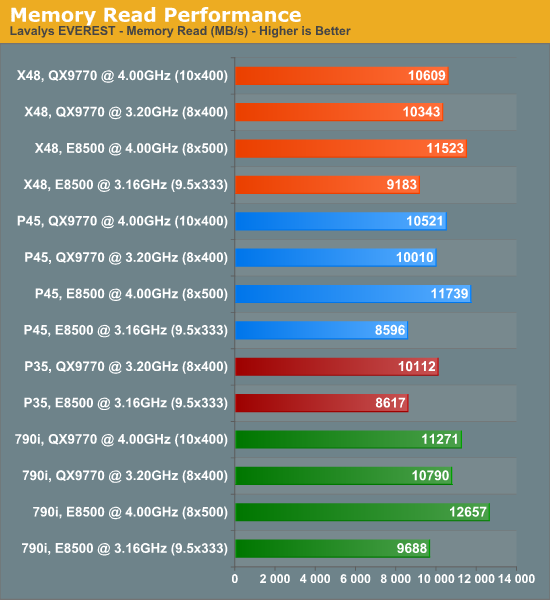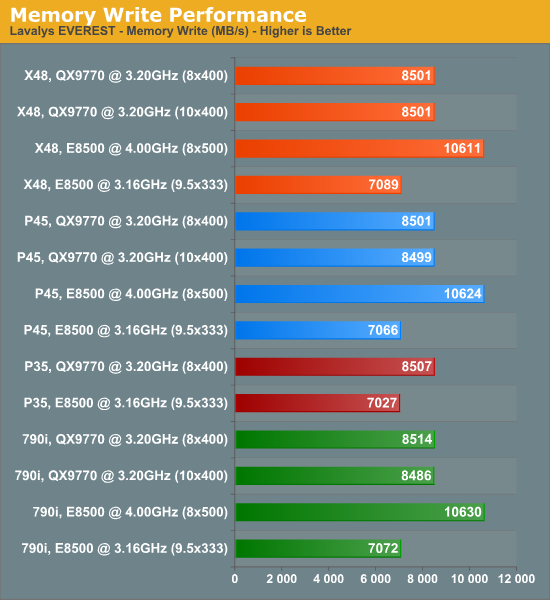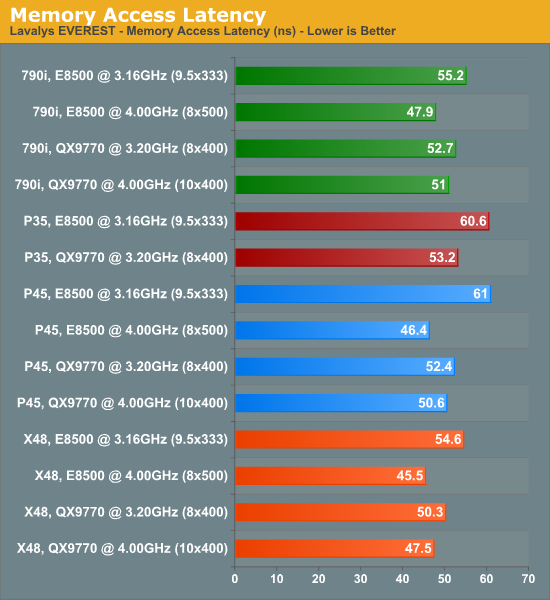ASUS P5Q3 Deluxe: An Early Preview of P45 Express Performance
by Kris Boughton on May 13, 2008 2:00 PM EST- Posted in
- Motherboards
Memory Performance (Read, Write, Copy and Access Latency)

Our memory read performance results indicate that P45 is a strong performer moderate to high bus speeds when compared to X48. The X48 chipset holds a commanding lead until an FSB of about 450MHz wherein P45 pulls ahead and takes the gold. The combination of higher bus speeds and high CPU frequencies seems to magnify the P45 performance advantage when compared to X48. Clock-for-clock the 790i-Ultra chipset clobbers both P45 and X48, at least when it comes to raw memory read bandwidth.

Seeing as how memory write performance scales almost perfectly with FSB and little else, there were no surprises when it came testing each memory controller's ability to write to system memory. Our results were well within the margin of error needed to quote each controller as being equal when it came to handling sustained memory writes.

Once again X48 puts on a superior performance at low to moderate bus speeds but falls behind P45 when pushing towards 500MHz FSB. Those that are looking to purchase low-multiplier CPUs that will demand high bus speeds in order to achieve maximum core frequencies will be wise to consider a P45-based board. Interestingly, the 790i-Ultra board, the Striker II Extreme, shows problems keeping up with Intel when it comes to memory copy performance. Intel's heavy investment in prefetcher algorithm tuning has definitely paid dividends as Intel chipsets consistently out-perform NVIDIA chipsets when it comes to effectively simultaneously balancing memory read and write performance.

Depending on where you plan on running your system each of the three chipsets performs differently when compared to the others. However, if asked we would give the nod to the Intel X48 chipset for consistently putting up the lowest access latency times, a fact which sometimes provides a significant performance advantage when running memory-sensitive benchmarks.










30 Comments
View All Comments
DigitalFreak - Tuesday, May 13, 2008 - link
Didn't bother to even read the article, did you?JarredWalton - Tuesday, May 13, 2008 - link
See the conclusion. As always, SLI requires an NVIDIA chipset to work. This board does support CrossFire however - in 2x8 PCIe 2.0 configuration, which matches the bandwidth of 2x16 PCIe 1.x seen on implementations like AMD's earlier Xpress 3200 chipset. I seriously doubt doubling the PCIe bandwidth will improve performance all that much, so this looks to be a very good midrange option for CF users. (Note that my personal gaming rig runs X38 and 3870 CF.)deruberhanyok - Tuesday, May 13, 2008 - link
I've got a P965 board and was thinking of replacing it with a P35 board. I keep putting it off for one reason or another.IMO there's a handful of things about P45 that make it interesting to me and potentially worth a little extra wait, but I'm not sure how they'll pan out:
* lower power consumption - curious to see how final silicon will compare to P35
* ICH10 - I thought this is supposed to have a built in wireless-N NIC capability? If it does, hopefully someone will make use of it
* PCI Express 2.0 - whether this really makes a difference over 1st gen or not, it's a nice marketing bullet point
Also, seeing a new Analog Devices CODEC makes me smile. Looking forward to seeing info on Asus' mainstream version of this (which I'm guessing would be a P5Q-E or thereabouts), hopefully it will sit around the same price as the P5K-E.
Thanks for the article!
npp - Tuesday, May 13, 2008 - link
The board is a very strong offering from Asus, no doubt about that. I don't see any reasons to upgrade from something like P35, though, the differences in both performance and power consumption simply aren't large enough for me to justify it. Generally speaking, buying a relatively expensive product when a major platform shift is imminent can never be easily justified - like buying a Pentium 955EE just before the Core 2 Launch :]Continuing with the obvious "Nehalem" argument - I don't find it wise to recommend DDR3 today, either, just to see it bottlenecked by the antique FSB... Correct me if I'm wrong, but FSB 400 provides theoretical bandwidth of 12800 MB/s, which is easily surpassed by even a single DDR3-1800 module. Having ~3x that bandwidth sounds like a much more convincing argument for an upgrade for me :]
Gerbilhamster - Tuesday, May 13, 2008 - link
hard to make a comparisonAmberClad - Tuesday, May 13, 2008 - link
My ears perked up at the supposed support for 16GB of DDR2. Granted, 4GB dimms aren't exactly commonplace yet, but the theoretical ability to have 8GB with only two slots populated is pretty intriguing. I'm just thinking of all the apps I can leave in the background with all that spare memory available o_o.Staples - Tuesday, May 13, 2008 - link
In a few months, people will be thinking of upgrading from their P35 to the P45. I think for this reason the P35 should be included in every benchmark including the power consumption graph.DigitalFreak - Tuesday, May 13, 2008 - link
Only someone with more money than sense would upgrade from a P35 to a P45 board.Egglick - Tuesday, May 13, 2008 - link
I agree, but for different reasons. The P35 is much less expensive, and if performance is close enough, it could be a better choice until prices on the P45 drop. I personally find $250 for a motherboard to be unacceptable.The only reason I even read the article was to see how the two compared.
JarredWalton - Tuesday, May 13, 2008 - link
A P35 comparison is forthcoming; Kris didn't have an appropriate board on hand for this article (and he's apparently running around in Asia right now).